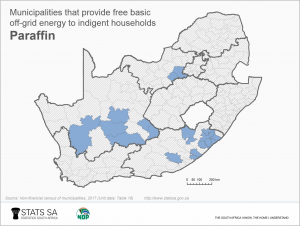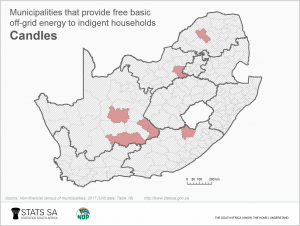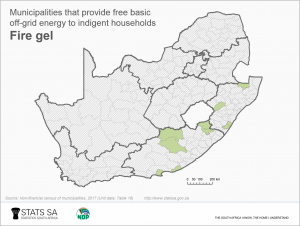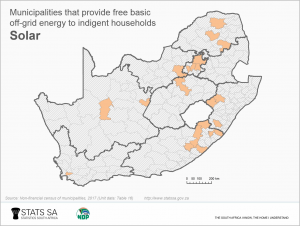Energy and the poor: a municipal breakdown
In April, government reaffirmed its commitment to renewable energy. The Department of Energy signed agreements with 27 independent power producers (IPPs), effectively unlocking R56 billion that will be invested in renewable energy projects across the country, predominantly in rural areas.
Jeff Radebe, the Minister of Energy, outlined the importance of moving forward with renewable energy initiatives, arguing that lower electricity prices brought about by clean energy will help indigent households cope with the rising cost of living 1,2.
Indigent households were also the focus of Stats SA at a recent media event on the release of the latest Non-financial census of municipalities report. A lesser known fact about the report – that is relevant to government’s recommitment to renewable energy – is that it provides data on the extent to which municipalities provide off-grid energy sources to poorer households, including solar energy.
A family requires energy for three main tasks: cooking, heating and lighting. Electricity is an ideal source as it can be used to perform all these three tasks. But what if a household is located in an area that doesn’t have access to the power grid and/or doesn’t have the means to afford other forms of energy?
Municipalities step in to help. The Free Basic Alternative Energy Policy3 instructs municipalities to select suitable off-grid energy sources, and to provide access to these indigent households.4 The policy lists paraffin, liquid petroleum gas, bio-ethanol gel (or fire gel), and coal as options.
To what extent are municipalities providing these sources, including solar energy? Of South Africa’s 213 local and metropolitan municipalities, 49 indicated that they are servicing indigent households with at least one form of off-grid energy source5, according to the Non-financial census of municipalities report.
The maps below show which municipalities are providing paraffin, candles, fire gel and solar energy. JB Marks Local Municipality in North West (covering the Potchefstroom/Ventersdorp area) is the only municipality that provides liquefied petroleum gas. It is also the municipality that provides the most number of options (i.e. liquefied petroleum gas, paraffin, candles and solar).
Over 86 500 indigent households (2,5% of the 3,5 million indigent households nation-wide) benefit from free paraffin in 20 municipalities. These municipalities are clustered in Eastern Cape and Northern Cape, with two municipalities in North West.
There are still households in South Africa that rely heavily on candles. Just over 5% of South Africa’s 16,6 million households use candles as a main source of lighting, according to the General Household Survey (GHS) 2016 report.6
Seven municipalities provide candles as an off-grid source to almost 13 700 indigent households, comprising 0,4% of indigent households nation-wide.
Fire gel is used as a source of free off-grid energy in 10 municipalities in Eastern Cape and KwaZulu-Natal, benefitting just over 19 600 households (0,6% of all indigent households).
There were 22 municipalities providing free solar electricity systems. About 113 200 households (3,2% of the 3,5 million indigent households nation-wide) benefitted from this service.
It comes as no surprise that this percentage has gone up, from 2,8% in 2016. The country basks in sunshine throughout the year. The estimated figure for the annual 24-hour global solar radiation average, according to the Department of Energy, is about 220 W/m2 for South Africa. This is higher than the average recorded for Europe (100 W/m2) and parts of the USA (150 W/m2).7
Rural municipalities focus mostly on providing energy sources such as paraffin, fire gel and candles. In terms of solar energy, three metropolitan municipalities in Gauteng (Johannesburg, Tshwane and Ekurhuleni) have joined the initiative, providing free solar home systems to almost 57 200 households.
In celebrating energy month in May, the Minister of Energy stated that the Department of Energy is aiming to enhance South Africa’s energy mix by increasing clean energy’s contribution to 30% by the year 2025.8 As the costs of producing photovoltaic panels continue to decline, providing solar energy as a service to poorer households might become a more attractive option. In time, solar energy will hopefully replace candles, paraffin and fire gel.
Download the latest Non-financial census of municipalities report here. The data used to create the maps above can be found in the unit data Excel file (Tables 16 and 17), available for download here.
1 BusinessTech, Government signs 27 independent renewable energy agreements (read here).
2 ENCA, Minister insists renewable energy will boost jobs, transformation (read here).
3 Download the Free Basic Alternative Energy Policy here.
4 Municipalities adopt indigent support programmes to ensure that poor households (that are unable to pay for certain basic services) have access to water, electricity, sanitation and refuse removal. Households can apply for indigent status with their respective municipalities. If a household’s application is successful – if it meets specific criteria – then it receives services for free or at greatly-reduced rates.
5 Off-grid energy sources are only provided by local and metropolitan municipalities. South Africa is currently made up of 44 district and 8 metropolitan municipalities. District municipalities are in turn subdivided into 205 local municipalities.
6 General Household Survey (GHS), 2016, Table 8.7.3 (download the report here).
7 Department of Energy, Renewable energy (read here).
8 ESI Africa, South Africa: DoE celebrates energy month (read here).





